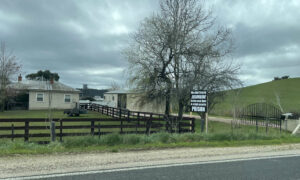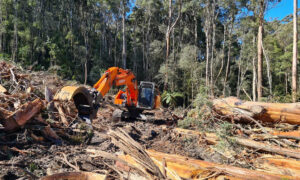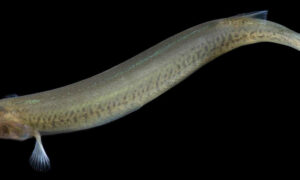THE arc of a rainbow spread across the Waterworks Valley as I hurried home to beat the rain.
I had been walking below Fern Tree when a storm cloud rolled off Mount Wellington. I rushed through the Waterworks Reserve, only for the sun to burst from behind the mountain, pursuing the clouds. I stopped in my tracks, marvelling not at the rainbow but the native forest it embraced and framed.
The setting sun highlighted the multi-coloured speckled and streaked eucalypt bark. The long, pianist-finger gum leaves looked longer than ever, edged by their shadows. Even the squat and dowdy wattles – as they had appeared to me out of flower and in the company of stately blue and white gums – sparkled with life in the reflected glory of the rainbow, painted in pastel shades of indigo, red, orange and yellow across the sky.
A forest is a wondrous thing and it does not take a rainbow to make the observer view it in a new light but these days when I see woodland I think of destruction and the rapid pace at which mature trees are vanishing all over the world.
Why does mankind appear to hate pristine forests so, and always contrive to chop them down? The history of human civilisation is marked by the destruction of woodland, first to create pasture and then to harvest the trees themselves.
Lost trees mean lost birdlife
I suppose forests, with their dark threat hidden within, were once places to be feared and European culture is steeped in the dangers their inhabitants posed to Little Red Riding Hood and others unfortunate enough to live at their fringe. But, along with our primeval fear of snakes, we should have got over that long ago and learned to appreciate the forest for its wonder and beauty and, most of all, for what trees hold for our own survival and also the survival of creatures that share the planet with us.
We all know the forests of the world are under threat. Forest clearance though is not only a problem confined to developing nations which still undergo the struggle for food self-sufficiency in all seasons, and are also lured by the hard currency mature trees can bring. In the first years of the new millennium more than half a million hectares of Australian woodland was still vanishing under the chainsaw, or worse, by poisoning or the tractor-drawn chain.
As a bird-watcher, I immediately interpret lost trees as lost birdlife and the annual obliteration of woodland takes with it several million birds.
From the rotting leaf litter on the forest floor to the tips of the tallest trees and the air alive with flying insects beyond, woodland is home to a wide diversity of species that find food in every nook and cranny.
Bright red breasts
A 20-minute walk around the Waterworks Reserve circular track embracing the Gentle Annie Falls will reveal about 30 woodland species on a summer’s day. With a bit of luck Bassian thrushes can be seen fossicking in the wet mulch and, perching on tree stumps above them, dusky robins and satin flycatchers watch for insects. Along the track, the bright red breasts of scarlet robins pierce the shrubbery and in grassy areas under eucalypts too shady for shrubs to grow, a male superb fairy-wren scampers for food, watched by dull-brown females.
On the tree bark itself strong-billed honeyeaters and scrubtits probe for invertebrates, with black-headed honeyeaters gleaning food from the boughs.
In the canopy, swift parrots, green rosellas and yellow-throated honeyeaters feed on blossom, and from the tops of skeletal dead trees, the calls of grey currawongs and forest ravens ring out across the Waterworks Valley. Soaring above them, snatching insects rising from the leaves, are dusky woodswallows, welcome swallows and tree martins.
This snippet of forest life, viewed through the prism of a simple cross-section of birds, demonstrates that the woodland ecology is a complex one, in which the dead takes a vital place alongside the living.
The dead feed the living
In the chaos that is the virgin, untrammeled forest there is order and regeneration and the dead not only feeds the living but also provides nesting sites for cavity-nesting species, which include most of the parrots.
If not destroying woodland entirely for fields and pasture, agriculture’s attempt to re-create forests in plantations falls far short of the real thing for the wildlife living there. Neat, manicured plantations, even with native species, lack the vital ingredients for the entire cycle of life and death. It is a lesson we must learn if the forestry industry is to become truly compatible with nature.
Standing in the rain, at the top end of the Waterworks Reserve, it was easy to view the pristine forest as a pot of gold at the end of nature’s rainbow.
Donald Knowler, apart from being a journalism legend and a real Wild Turkey, is On the Wing columnist in The Saturday Mercury. He read this column during the launch of Island 100 of which it is a part.
More about Island:


























Simon Parsons
April 11, 2005 at 01:08
Fantastic idea. Let’s do it. Do you have any idea where and how to start?